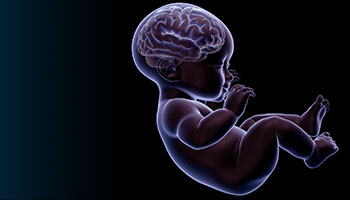HOW CAN WE HELP YOU? Call 1-800-TRY-CHOP
In This Section
Microbubble Technology Offers Noninvasive Monitoring of Intracranial Pressure

Misun Hwang, MD, is developing a noninvasive monitoring system to measure intracranial pressure using contrast-enhanced ultrasound.
mccannn [at] chop.edu (By Nancy McCann)
Placement of an invasive catheter into the brain is the conventional neuromonitoring procedure for measuring intracranial pressure (ICP). With the placement of this sensor comes the risk of infection, hemorrhage, and brain injury. A reliable, noninvasive monitoring method, which could facilitate early neurosurgical interventions to alleviate pressure and avoid lasting brain injury, is much needed, and Misun Hwang, MD, attending radiologist at Children’s Hospital of Philadelphia is on the road to discovery.
By using microbubble technology, Dr. Hwang and her colleagues have found a way to precisely predict ICP and ischemia by studying the trajectory and velocity of these bubbles working with a porcine model of pediatric hydrocephalus. Their research is supported with a grant from the National Institute of Neurological Disorders and Stroke.
Doing a Better Job to Manage Hydrocephalus
Hydrocephalus involves abnormal cerebrospinal fluid (CSF) accumulation in the brain ventricles and affects one to two of every 1,000 live births. It’s the leading cause for brain surgery in newborns and results in long-term neurologic disabilities in more than 75 percent of patients.
The elevated ICP can lead to inadequate blood flow to the brain, inflammation, secondary neurovascular damage, and brain herniation. A ventricular shunt is the most common treatment to alleviate ICP and to divert the CSF to another anatomical location outside of the central nervous system. Due to the many risks involved, the invasive sensor used to accurately measure ICP and guide the timing of shunting in adults is rarely used with pediatric patients — especially infants. While noninvasive methods have been tried, these tools have not proven accurate. Without a precise measurement, there’s no reliable way to guide clinicians as to when to intervene with a shunt.
For infants and children, the clinical decision for this surgical intervention relies primarily on ultrasound (US) or computed tomography (CT) depicting enlarged brain ventricles and clinical signs of increased ICP. Unfortunately, the currently used imaging and clinical criteria for shunting are not precise enough to detect brain tissue at risk of ischemia and irreversible brain damage.
“Severely dilated ventricles prompt shunting of CSF,” Dr. Hwang said, “but at that point brain damage may have already occurred. Even if we do the best from a neurosurgical point of view, the patient can go on to develop adverse neurodevelopmental sequelae, such as cerebral palsy. So, we need to do a better job of guiding the management of these infants and identifying the earliest timepoint for neuroprotective intervention that can improve survival and long-term outcomes in these patients.”
Microbubble Technology — How It Works
With the U.S. Food and Drug Administration approval of the use of contrast-enhanced ultrasound (CEUS) in children, CHOP established the Center for Pediatric Contrast Ultrasound (CPCU), a collaboration of the Divisions of Body Imaging and Interventional Radiology in the Department of Radiology, as well as the Division of Emergency Medicine in the Department of Pediatrics. As an ultrasound contrast agent, gas-filled microbubbles are intravenously injected and course through the blood vessels. These bubbles are seen as bright structures when imaging with ultrasound due to their ability to reflect ultrasound waves.
“Their signal therefore informs of organ perfusion and injury,” Dr. Hwang said.
Using this ultrasound technology, Dr. Hwang’s team, including Todd Kilbaugh, MD, anesthesiologist and pediatric intensivist, and Angela Viaene, MD, PhD, neuropathologist — both of CHOP; and Joseph Katz, PhD, a mechanical engineering professor at Johns Hopkins University, are working with hydrocephalic pediatric porcine models to track the changes in blood flow in the brain. As the ventricles dilate due to the abnormal buildup of cerebrospinal fluid, the brain compresses, changing the blood flow. By applying an advanced processing algorithm, they are able to map the cerebral circulation at several microns in resolution and accurately assess ICP levels.
“What’s clinically relevant is that these bubbles are so miniscule that they’re able to characterize the flow even in capillaries in vivo, and no other imaging can detect these small vessels with such superb resolution at this moment,” Dr. Hwang said. “It gives insights into the integrity of microvascular flow and health. We’re actually detecting the secondary changes in cerebral blood flow as a consequence of increasing ICP. The strength of our imaging tool is the ability to assess ICP with precision, which can ultimately obviate the need for invasive ICP monitoring.”
While additional research remains to be done before this technology goes from bench to bedside monitoring, Dr. Hwang believes this could be paradigm shifting in neonatal hydrocephalus care. She would like to see the process automated to where the clinician injects contrast, does a scan, and within minutes, a precise measure will be revealed for guidance of personalized medical management.
“Our work will set the stage for clinical translation of a new noninvasive tool for assessment of ICP and brain ischemia in neonatal hydrocephalus,” Dr. Hwang said, “which can ultimately improve the guidance of shunting and long-term neurologic outcomes.”